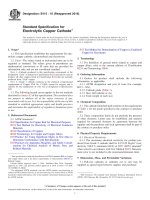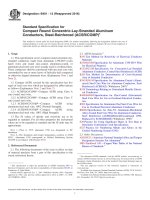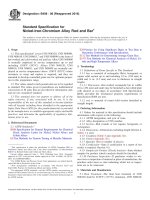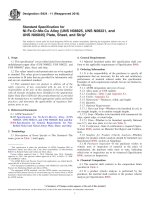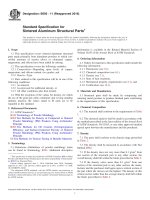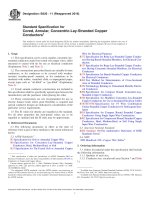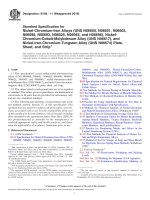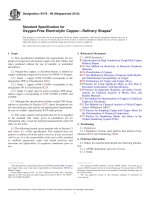Astm b 687 99 (2016)
Bạn đang xem bản rút gọn của tài liệu. Xem và tải ngay bản đầy đủ của tài liệu tại đây (115.32 KB, 5 trang )
Designation: B687 − 99 (Reapproved 2016)
Standard Specification for
Brass, Copper, and Chromium-Plated Pipe Nipples1
This standard is issued under the fixed designation B687; the number immediately following the designation indicates the year of
original adoption or, in the case of revision, the year of last revision. A number in parentheses indicates the year of last reapproval. A
superscript epsilon (´) indicates an editorial change since the last revision or reapproval.
This standard has been approved for use by agencies of the U.S. Department of Defense.
1. Scope*
2.3 Military Standard:
MIL-STD-105 Sampling Procedures and Tables for Inspection by Attributes4
1.1 This specification establishes the requirements for brass
and copper pipe nipples in standard pipe sizes from 1⁄8 to 8 in.,
inclusive, in standard lengths, and chromium-plated pipe
nipples in standard pipe sizes from 1⁄8 to 2 in., inclusive, in
standard lengths.
1.1.1 Chromium-plated pipe nipples ordered under this
specification are intended for interior use in decorative applications.
3. Terminology
3.1 Definitions:
3.1.1 For definitions of terms relating to copper and copper
alloys, refer to Terminology B846.
4. Ordering Information
1.2 The values stated in inch-pound units are to be regarded
as standard. The values given in parentheses are mathematical
conversions to SI units that are provided for information only
and are not considered standard.
1.3 This standard does not purport to address all of the
safety concerns, if any, associated with its use. It is the
responsibility of the user of this standard to establish appropriate safety and health practices and determine the applicability of regulatory limitations prior to use.
4.1 Contracts and purchase orders for product under this
specification are to contain the following information:
4.1.1 ASTM specification designation and year of issue,
4.1.2 Type of material (Section 5),
4.1.3 Weight of material; regular or extra strong,
4.1.4 Diameter; nominal or actual outside diameter,
4.1.5 Length; standard or special (8.2 andTable 2), and
4.1.6 Quantity; number of pieces or total weight of each
material and size.
4.2 The following options are available under this specification and are to be specified in the contract or purchase order
when required:
4.2.1 Chromium plated finish,
4.2.2 Short Plumbing (hospital) threads,
4.2.3 Certification (Section 16), and
4.2.4 Test and Inspection Reports, if required (Section 17).
2. Referenced Documents
2.1 ASTM Standards:2
B42 Specification for Seamless Copper Pipe, Standard Sizes
B43 Specification for Seamless Red Brass Pipe, Standard
Sizes
B456 Specification for Electrodeposited Coatings of Copper
Plus Nickel Plus Chromium and Nickel Plus Chromium
B846 Terminology for Copper and Copper Alloys
E29 Practice for Using Significant Digits in Test Data to
Determine Conformance with Specifications
2.2 ANSI/ASME Standard:
B1.20.1 Pipe Threads, General Purpose (Inch)3
4.3 In addition, when material is purchased for agencies of
the U.S. government, it shall conform to the supplementary
requirements as defined herein when specified in the contract
or purchase order.
5. Materials and Manufacture
5.1 Copper pipe nipples shall be produced from regular or
extra strong pipe conforming to the requirements of Specification B42.
1
This specification is under the jurisdiction of ASTM Committee B05 on Copper
and Copper Alloys and is the direct responsibility of Subcommittee B05.04 on Pipe
and Tube.
Current edition approved April 1, 2016. Published May 2016. Originally
approved in 1981. Last previous edition approved in 2011 as B687 – 99 (2011).
DOI: 10.1520/B0687-99R16.
2
For referenced ASTM standards, visit the ASTM website, www.astm.org, or
contact ASTM Customer Service at For Annual Book of ASTM
Standards volume information, refer to the standard’s Document Summary page on
the ASTM website.
3
Available from American National Standards Institute (ANSI), 25 W. 43rd St.,
4th Floor, New York, NY 10036, .
5.2 Brass pipe nipples shall be produced from regular or
extra strong pipe conforming to the requirements of Specification B43.
4
Available from DLA Document Services, Building 4/D, 700 Robbins Ave.,
Philadelphia, PA 19111-5094, .
*A Summary of Changes section appears at the end of this standard
Copyright © ASTM International, 100 Barr Harbor Drive, PO Box C700, West Conshohocken, PA 19428-2959. United States
1
B687 − 99 (2016)
TABLE 1 Short Plumbing (Hospital) ThreadsA,
B
standard pipe size nipples shall be short plumbing (hospital)
threads, in accordance with Table 1. On 1⁄8 to 1-in. standard
pipe size nipples, short plumbing (hospital) threads, if
specified, shall be in accordance with Table 1.
NOTE 1—Short plumbing (hospital) threads are normally used only on
chromium-plated nipples. The purpose of such threads is that a minimum
of thread shall remain exposed after the nipple is screwed into a fitting.
Overall External
Thread Length, L4
Nominal
Pipe Size,
NPS
Outside
Diameter
of Pipe, D
Threads
per in.,
N
Inches
Threads
⁄
⁄
3⁄ 8
1⁄ 2
3⁄ 4
1
1 1⁄ 4
1 1⁄ 2
2
0.405
0.540
0.675
0.840
1.050
1.315
1.660
1.900
2.375
27
18
18
14
14
111⁄2
111⁄2
111⁄2
111⁄2
0.26
0.33
0.33
0.43
0.43
0.52
0.52
0.52
0.52
7
6
6
6
6
6
6
6
6
18
14
9. Workmanship, Finish, and Appearance
9.1 End Finish—The ends of the pipe nipples shall be
chamfered on the outside at an angle of 35 6 10° to the central
axis. (It is standard practice that the 1⁄8-in. nominal size nipples
need not be chamfered.) Ends shall be cut reasonably square to
the central axis. All burrs on the outside shall be removed.
9.2 Chromium Plating—Chromium plate on brass nipples
shall meet the requirements of service condition SC I of
Specification B456, except the equivalent nickel thickness
shall be 0.003 mm.
A
All dimensions, except threads per inch, in inches.
This table represents a modification of Table 2 of ANSI B1.20.1; L4 is modified as
shown. E2, L2, and V are modified accordingly. The threads shall meet the gaging
requirements of Sections 6 and 11 of this specification.
B
10. Sampling
10.1 A random sample of pipe nipples shall be selected from
one production lot in accordance with MIL-STD-105 at Inspection Level II. In terms of defects per 100 units, the
Acceptable Quality Level (AQL) shall be 1.5.
10.1.1 Production Lot—A production lot shall be as determined by the manufacturer, provided that all of the pipe used
in a single production lot shall comply with the provisions of
Section 5 and all of the nipples shall be of the same size,
length, type, weight, finish, and thread form.
5.3 Chromium-plated pipe nipples shall be produced from
regular weight brass pipe conforming to the requirements of
Specification B43.
6. Chemical Composition
6.1 The chemical composition shall conform to the requirements of the specification under which the pipe was ordered.
7. Temper
11. Number of Tests and Retests
7.1 The product temper and its properties and characteristics
shall conform to the requirements of the specification under
which the pipe was ordered.
11.1 Allowances for resampling and retesting shall be in
accordance with the Inspection Level and Acceptable Quality
Levels detailed in 10.1.
8. Dimensions, Mass and Permissible Variations
12. Significance of Numerical Limits
8.1 Lengths:
8.1.1 The standard lengths and sizes of nipples generally
available are shown in Table 2. The availability of such nipples
indicated by pipe size are shown in Table 3.
8.1.2 Special lengths and sizes of nipples are permitted to be
specified when required. Standard and special lengths shall
conform to the tolerance requirements of 8.1.3.
8.1.3 Tolerances—Nipples with lengths up through 12 in.
(305 mm) long shall have a length tolerance of 61⁄16 in.
(1.6 mm). Nipples over 12 in. long shall have a tolerance of
61⁄8 in. (3.2 mm).
12.1 For the purpose of determining compliance with the
specified limits for the requirements listed in the following
table, an observed value shall be rounded as indicated in
accordance with the rounding method of Practice E29:
Property
Rounded Unit for
Observed or Calculated Value
Linear Dimensions
Tolerances
nearest unit in the last right-hand significant
digit used in expressing the limiting value
13. Inspection
13.1 Each sample nipple shall be examined visually to
verify conformance with each of the following requirements:
13.1.1 The material is the type and weight of material
specified,
13.1.2 The finish is as specified, if chromium-plated,
13.1.3 The ends are reasonably square to the central axis
and all burrs have been removed, and
13.1.4 Threads are not burred or damaged.
8.2 Threads:
8.2.1 Pipe nipples shall be threaded on both ends with NPT
Taper Pipe Threads conforming to the requirements of ANSI
B1.20.1, except for close nipples where L4 and V are shorter,
due to fewer imperfect threads. It is standard manufacturing
practice on all other nipple lengths to vary the L4 6 two
threads. All other dimensions, tolerances, and gaging practices
remain the same as ANSI B1.20.1, and the Annex.
8.2.1.1 Threads shall be right hand on both ends, except
when otherwise specified.
8.2.2 Threads, Chromium-Plated Nipples—Threads on
chromium-plated nipples shall be gaged after plating. Threads
on 1⁄8 to 1-in. standard pipe size nipples shall be NPT Taper
Pipe Threads, in accordance with 8.2.1. Threads on 11⁄4 to 2-in.
13.2 Each sample nipple shall be inspected to verify conformance with each of the following requirements:
13.2.1 Pipe size,
13.2.2 Length,
13.2.3 Thread dimensions, and
13.2.4 Chamfer.
2
B687 − 99 (2016)
TABLE 2 Pipe Nipples by Length and Pipe Size
Type of
Nipple
⁄
⁄
18
⁄
14
⁄
38
⁄
12
1
34
1 1⁄ 4
1 1⁄ 2
2
2 1 ⁄2
3
3 1⁄ 2
4
5
6
8
A B
Pipe Nipple Lengths, in. ,
Close (cl)
⁄
1 1⁄ 2
2
2 1⁄ 2
3
3 1⁄ 2
4
4 1⁄ 2
5
5 1⁄ 2
6
7
8
9
10
11
12
Right and left . . .
A
B
⁄
34
1
78
1 1⁄ 2
2
2 1⁄ 2
3
3 1⁄ 2
4
4 1⁄ 2
5
5 1⁄ 2
6
7
8
9
10
11
12
...
1 1⁄ 8
1 1 ⁄2
2
2 1 ⁄2
3
3 1 ⁄2
4
4 1 ⁄2
5
5 1 ⁄2
6
7
8
9
10
11
12
4
1 1 ⁄2
2
2 1 ⁄2
3
3 1 ⁄2
4
4 1 ⁄2
5
5 1 ⁄2
6
7
8
9
10
11
12
4
1 3 ⁄8
...
2
2 1⁄2
3
3 1⁄2
4
4 1⁄2
5
5 1⁄2
6
7
8
9
10
11
12
4
1 1⁄ 2
...
2
2 1⁄ 2
3
3 1⁄ 2
4
4 1⁄ 2
5
5 1⁄ 2
6
7
8
9
10
11
12
4
1 5⁄ 8
...
2
2 1⁄ 2
3
3 1⁄ 2
4
4 1⁄ 2
5
5 1⁄ 2
6
7
8
9
10
11
12
4
1 3⁄ 4
...
2
2 1 ⁄2
3
3 1 ⁄2
4
4 1 ⁄2
5
5 1 ⁄2
6
7
8
9
10
11
12
4
2
...
...
2 1⁄ 2
3
3 1⁄ 2
4
4 1⁄ 2
5
5 1⁄ 2
6
7
8
9
10
11
12
4
2 1 ⁄2
...
...
...
3
3 1⁄ 2
4
4 1⁄ 2
5
5 1⁄ 2
6
7
8
9
10
11
12
...
2 5⁄8
...
...
...
3
3 1⁄ 2
4
4 1⁄ 2
5
5 1⁄ 2
6
7
8
9
10
11
12
...
2 3⁄ 4
...
...
...
...
...
4
4 1⁄ 2
5
5 1⁄ 2
6
7
8
9
10
11
12
...
2 7⁄ 8
...
...
...
...
...
4
4 1 ⁄2
5
5 1 ⁄2
6
7
8
9
10
11
12
...
3
...
...
...
...
...
...
4 1⁄2
5
5 1⁄2
6
7
8
9
10
11
12
...
3 1⁄ 8
...
...
...
...
...
...
4 1⁄ 2
5
5 1⁄ 2
6
7
8
9
10
11
12
...
3 1⁄ 2
...
...
...
...
...
...
...
5
5 1⁄ 2
6
7
8
9
10
11
12
Nipples shorter than close nipples are not recommended for pressure application.
1 in. = 25.4 mm.
TABLE 3 Pipe Nipple Sizes According to Material
14. Rejection and Rehearing
Nominal Pipe Sizes, in.
Weight
Regular weight brass
Extra strong brass
Regular copper
Extra strong copper
Chromium-plated regular brass
⁄ to 2
in., incl
21⁄4 to 4
in., incl
5 and 6
in.
8 in.
X
X
X
X
X
X
X
X
X
...
X
X
X
...
...
X
X
X
...
...
18
14.1 Rejection:
14.1.1 Product that fails to conform to the requirements of
this specification when inspected by the purchaser or purchaser’s agent, shall be subject to rejection.
14.1.2 Rejection shall be reported to the manufacturer or
supplier promptly and in writing.
14.1.3 In case of dissatisfaction with the results upon which
rejection is based, the manufacturer or supplier is permitted to
make claim for a rehearing.
13.3 Chromium Plating—Unless otherwise specifically
agreed upon between the manufacturer and the purchaser, the
individual samples need not be individually inspected as to
their chromium plating. It shall be sufficient for the manufacturer to certify that (a) random nipples from the chromium
plating process have been tested for conformance with Specification B456 (which records shall be retained by the manufacturer) and do in fact conform and (b) there has been no
significant change in the chromium plating process since the
tests were last run.
13.3.1 If inspection of the individual nipples is agreed upon,
then it shall be conducted by any method allowed by Specification B456.
14.2 Rehearing:
14.2.1 As a result of product rejection, the manufacturer or
supplier is permitted to make claim for a retest to be conducted
by the manufacturer or supplier and the purchaser. Samples of
the rejected product shall be taken in accordance with this
product specification, and subjected to test by both parties
using the test methods specified in the product specification, or,
alternatively, upon agreement of both parties, an independent
laboratory shall be selected.
15. Certification
15.1 When specified in the contract or purchase order, the
purchaser shall be furnished certification that samples representing each lot have been tested or inspected as directed in this
specification and the requirements have been met.
13.4 Pipe—The pipe from which each production lot is
manufactured shall be of the same size, type, and weight and
shall be tested in accordance with the applicable ASTM pipe
specification. At the option of the manufacturer, the pipe may
be tested by the manufacturer, by the pipe mill that produced
the pipe, or by an independent laboratory.
16. Test and Inspection Reports
16.1 When specified in the contract or purchase order, a
report of test and inspection results shall be furnished.
13.5 Source Inspection—If required, source inspection of
the product by the purchaser shall be established by agreement
between the manufacturer or supplier and purchaser at the time
of placing the order. In such cases, the nature of the facilities
necessary for the inspector to determine that the product is in
conformance to this specification shall be included in the
agreement. The inspection shall be conducted so as not to
unnecessarily interfere with normal operations.
17. Packaging and Package Marking
17.1 Individual nipples are not normally identified. Nipples
packaged shall have their containers legibly marked to show
brand or name of manufacturer, quantity, size, length, type of
material, weight of material (if other than regular), and finish
(if chromium-plated).
3
B687 − 99 (2016)
17.1.1 At the manufacturer’s option, large size, extra long
nipples and odd lots are bagged or bundled with tags identifying the product as specified in 15.1.
for transportation at the lowest rate applicable and to afford
protection from the normal hazards of transportation.
17.2 Chromium-Plated Nipples—Except for close nipples,
chromium-plated nipples shall be individually packaged,
wrapped, or otherwise protected to ensure against nicking or
other cosmetic damage in transit.
18. Keywords
18.1 close nipple; pipe nipple; short plumbing (hospital)
threads
17.3 Nipples shall be packaged and prepared for shipment
in such a manner as to ensure acceptance by common carrier
SUPPLEMENTARY REQUIREMENTS
The following supplementary requirements shall apply only when specified by the purchaser in the
inquiry, contract, or order for agencies of the U.S. government.
TABLE S1.1 Dash Numbers for Regular and Extra Strong Brass or Copper Pipe Nipples
Nominal Pipe Size (in.)
⁄
18
⁄
14
⁄
38
⁄
12
⁄
34
Length ±1⁄16
⁄
⁄
1
1-1⁄8
1-3⁄8
1-1⁄2
1-5⁄8
1-3⁄4
2
2-1⁄2
2-5⁄8
3
3-1⁄2
4
4-1⁄2
5
5-1⁄2
6
34
B
1 1⁄ 4
1 1 ⁄2
2
2 1⁄ 2
3
1A
20A
78
A
1
Dash Numbers
39A
58A
77A
6B
24B
42B
60B
96A
115A
134A
9
10
27
28
45
46
63
64
81B
82
99B
100
118B
136B
152A
154B
172A
12
13
14
15
16
17
18
30
31
32
33
34
35
36
48
49
50
51
52
53
54
66
67
68
69
70
71
72
84
85
86
87
88
89
90
102
103
104
105
106
107
108
120
121
122
123
124
125
126
138
139
140
141
142
143
144
156
157
158
159
160
161
162
174B
175
176
177
178
179
180
191A
192B
193
194
195
196
197
198
Close type nipples.
Short type nipples.
All others are long type nipples.
FIG. S1.1 Example of Part Identifying Number
S1.2 The part number consists of the document identifier
followed by the code for the weight of material (regular or
extra strong), a dash, dash number (Table S1.1), material code,
and, if applicable, finish code (see example).
Example—Part Identifying Number “B687R-198BP” is constructed as follows in Fig. S1.1:
S1. Part Numbering System
S1.1 This supplement provides a part numbering system for
the identification of standard items for government use of
Specification B687.
NOTE 1—The government encourages the general use of this part
numbering system to achieve maximum parts standardization.
4
B687 − 99 (2016)
ANNEX
(Mandatory Information)
A1. GAGING TECHNIQUES FOR MALE THREADS
A1.1 An NPT working ring gage, in accordance with ANSI
B1.20.1, shall be turned hand tight on the nipple threads. The
gage shall be tapped or rapped against a solid surface and the
gage again turned hand tight into the thread. Hand tight means
turning the gage until moderate resistance is encountered—no
excessive force shall be used. After the second tightening
operation, the end of the thread should be flush to the gage
face, plus or minus one turn.
A1.2 The usual technique for tapping or rapping the gage is
to swing the end of the fitting with the ring gage attached
through an arc of approximately 4 to 6 in. (102 to 152 mm) to
allow the gage to strike against a solid metal surface. This
tapping procedure is used to eliminate any binding due to slight
nicks or foreign matter in the threads.
APPENDIX
(Nonmandatory Information)
X1. METRIC EQUIVALENTS
stress is the newton per square metre (N/m2), which has been
named the pascal (Pa) by the General Conference on Weights
and Measures. Since 1 ksi = 6 894 757 Pa the metric equivalents are expressed as megapascal (MPa), which is the same as
MN/m2 and N/mm2.
X1.1 The SI unit for strength properties now shown is in
accordance with the International System of Units (SI). The
derived SI unit for force is the newton (N), which is defined as
that force which when applied to a body having a mass of one
kilogram gives it an acceleration of one metre per second
squared (N = kg · m/s2). The derived SI unit for pressure or
SUMMARY OF CHANGES
Committee B05 has identified the location of selected changes to this standard since the last issue (B687-99)
that may impact the use of this standard. (Approved Mar. 1, 2005)
(1) Editorial modifications were made to conform with current
ASTM International and Committee B05 form and style
practices.
ASTM International takes no position respecting the validity of any patent rights asserted in connection with any item mentioned
in this standard. Users of this standard are expressly advised that determination of the validity of any such patent rights, and the risk
of infringement of such rights, are entirely their own responsibility.
This standard is subject to revision at any time by the responsible technical committee and must be reviewed every five years and
if not revised, either reapproved or withdrawn. Your comments are invited either for revision of this standard or for additional standards
and should be addressed to ASTM International Headquarters. Your comments will receive careful consideration at a meeting of the
responsible technical committee, which you may attend. If you feel that your comments have not received a fair hearing you should
make your views known to the ASTM Committee on Standards, at the address shown below.
This standard is copyrighted by ASTM International, 100 Barr Harbor Drive, PO Box C700, West Conshohocken, PA 19428-2959,
United States. Individual reprints (single or multiple copies) of this standard may be obtained by contacting ASTM at the above
address or at 610-832-9585 (phone), 610-832-9555 (fax), or (e-mail); or through the ASTM website
(www.astm.org). Permission rights to photocopy the standard may also be secured from the Copyright Clearance Center, 222
Rosewood Drive, Danvers, MA 01923, Tel: (978) 646-2600; />
5
